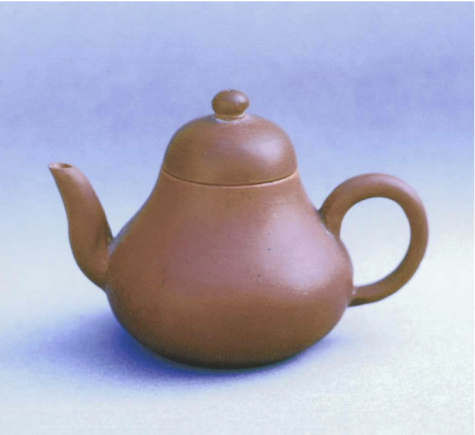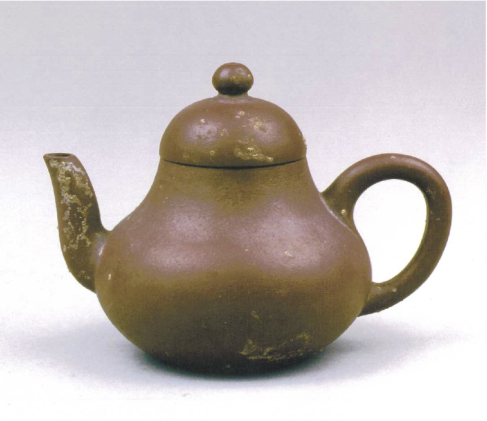Thanks to jump in lamppost, cause I really cannot answer you on the subjects you raise Tead Off, sorry. Maybe you should flamppost advice's advice and address them directly to Akira (right now, he is in Yunnan, climbing mountains I think).
Akira doesn't appear to me as someone who would deliberately lie in order to make profit. But this is my opinion based on my experience with him, and in the end that's up to everyone to make up one's mind on the subject. In trying to bring much information, I believe the probability to be wrong increases. I guess he cannot double check everything he's hearing also.
Maybe Tead Off, you just don't like Sado clay effects on tea. As for Watanabe Tozo teapots finish, I own 2 myself and I really cannot complain.
Lamppost, your Gisui pot is gorgeous ! So, is the deep fermented dong ding better with Gisui or Ken's pot ?
Re: What kind of pot for Li Shan Oolong? (Or Bai Ji Guan)
So far, I used 100g of Dong Ding and had about 15 sessions. For the last 5 sessions, I used Gisui. At first, I liked Ken's pot. It does enhance the tea's after taste. Unlike Ken's pot, Gisui's does not enhance the tea's after taste greatly, but it does give me both aroma and after taste. Overall all, I choose Gisui. The main reason is that the Dong Ding's unique aroma is reduced significantly after 3rd brew with Ken's pot.David R. wrote:Lamppost, your Gisui pot is gorgeous ! So, is the deep fermented dong ding better with Gisui or Ken's pot ?
I hope that helps.
Re: What kind of pot for Li Shan Oolong? (Or Bai Ji Guan)
It does, thanks a lot. I am usually ok with loosing a little aroma to gain aftertaste. That's why he told me black reduction clay would be a good choice.
For your information, I thought this teapot removed a bit of the sweet/sugar flavour of taiwanese tea. So I asked him and he told me that it would get better over time.
I also asked him about the difference between this clay and the new red clay. He answered me this : "The new Shimizu Ken's red clay gives also very strong after taste with much stronger aroma. For brewing oolong, I somehow like his red clay."
I for myself have a wonderful old Yixing for those teas. Even though,
I have to admit I'd be curious to test this kind of teapot...
For your information, I thought this teapot removed a bit of the sweet/sugar flavour of taiwanese tea. So I asked him and he told me that it would get better over time.
I also asked him about the difference between this clay and the new red clay. He answered me this : "The new Shimizu Ken's red clay gives also very strong after taste with much stronger aroma. For brewing oolong, I somehow like his red clay."
I for myself have a wonderful old Yixing for those teas. Even though,
I have to admit I'd be curious to test this kind of teapot...
Re: What kind of pot for Li Shan Oolong? (Or Bai Ji Guan)
David and TeadOff
To me, buying Hojo’s teapots is similar to buying new digital cameras: you can find new cheaper and better cameras every spring.
After many conversations and discussions with him, I noticed few things.
1. He believes that Japan has good clays for tea, and Japanese’s artists may have not find the best way to master their baking technique as the Chineses’ artists have done hundred years ago.
2. He is researching for a best way to advance Japanese clays. In short, Hojo’s customers are somewhat funding for his experiments.
3. His teapots do perform well, and the clays are getting better.
4. Beside Gisui’s teapots, Sado clay’s teapots are more affordable today then 2 years ago. If I recalled correctly, the price of a Watanabe Tozo’s small teapot was about 28000 JYP. The USD was also strong then 1 USD = 90+ JYP.
IMHO, some of us who have spent a lot of money to invest on Hojo teapots would not be happy with the information in 2,3, and 4.
If I had a time machine, I would go back to the past and get myself a gaiwan and never google the world “Yixing.” Collecting teapots is an addictive and expensive hobby; and indeed, using teapot does change my tea experience.
To me, buying Hojo’s teapots is similar to buying new digital cameras: you can find new cheaper and better cameras every spring.
After many conversations and discussions with him, I noticed few things.
1. He believes that Japan has good clays for tea, and Japanese’s artists may have not find the best way to master their baking technique as the Chineses’ artists have done hundred years ago.
2. He is researching for a best way to advance Japanese clays. In short, Hojo’s customers are somewhat funding for his experiments.
3. His teapots do perform well, and the clays are getting better.
4. Beside Gisui’s teapots, Sado clay’s teapots are more affordable today then 2 years ago. If I recalled correctly, the price of a Watanabe Tozo’s small teapot was about 28000 JYP. The USD was also strong then 1 USD = 90+ JYP.
IMHO, some of us who have spent a lot of money to invest on Hojo teapots would not be happy with the information in 2,3, and 4.
I am also looking for an old zhuni yixing for Ali Shan/Li Shan Oolong but it is hard to find a trusted vendor who knows a lot of Yixing old clays. Also, they are very expensive.David R. wrote: I for myself have a wonderful old Yixing for those teas. Even though,
I have to admit I'd be curious to test this kind of teapot...
If I had a time machine, I would go back to the past and get myself a gaiwan and never google the world “Yixing.” Collecting teapots is an addictive and expensive hobby; and indeed, using teapot does change my tea experience.
Re: What kind of pot for Li Shan Oolong? (Or Bai Ji Guan)
For Li Shan I'd like tall-shaped Zhuni (like Si Ting)
For Bai Ji Guan..I want stout one cos their leaves are long..best when pair elegant Zhaozhuang Zhuni hmmm..
For Bai Ji Guan..I want stout one cos their leaves are long..best when pair elegant Zhaozhuang Zhuni hmmm..
Re: What kind of pot for Li Shan Oolong? (Or Bai Ji Guan)
Chrl42,chrl42 wrote:For Li Shan I'd like tall-shaped Zhuni (like Si Ting)
Could you please tell me what is the volume of Zhuni Si Ting that you can suggest?
I just received a gift for a good friend who is a Taiwanese art collector. He gave me a 200ml+ Si Ting pot. The teapot's lit does not fit completely. I am hoping that it is an old zhuni teapot.

Thx.
Re: What kind of pot for Li Shan Oolong? (Or Bai Ji Guan)
I have a lot of respect for Hojo and his attempt at bringing more info about clay and tea to the public. He also has a very good eye for aesthetics and I like his style. His website, however, is a mess, and this style of having to ask for price lists for a public site on the web is kind of silly, no matter what the reasoning behind it. I've never thought that Hojo is trying to fool anyone or not telling the whole truth. But, he does try to make statements about the clay that are ultimately subjective and don't hold up for all tea drinkers. Let's not forget he does have a business to run.
The comparison of sado vs zhuni is again subject to many variables. Clay processing, manufacture, kiln type/placement/heat/atmosphere/moon position/mind of potter/alcohol intake, etc. Add to that the mind of the drinker and we have fantasy land once again. I will say that I like the aesthetics of the Sado pots and Japanese style overall. Yixing potters seem to have lost much of their creativity preferring to re-create over and over again, traditional themes. Even Chao Zhou potters have gone further in introducing new styles and variations on old themes to give their pots a freshness and appeal for modern drinkers. Chao Zhou zhuni are also very good for Taiwan oolongs and Dancong teas, often giving very good value for $$.
The comparison of sado vs zhuni is again subject to many variables. Clay processing, manufacture, kiln type/placement/heat/atmosphere/moon position/mind of potter/alcohol intake, etc. Add to that the mind of the drinker and we have fantasy land once again. I will say that I like the aesthetics of the Sado pots and Japanese style overall. Yixing potters seem to have lost much of their creativity preferring to re-create over and over again, traditional themes. Even Chao Zhou potters have gone further in introducing new styles and variations on old themes to give their pots a freshness and appeal for modern drinkers. Chao Zhou zhuni are also very good for Taiwan oolongs and Dancong teas, often giving very good value for $$.
Re: What kind of pot for Li Shan Oolong? (Or Bai Ji Guan)
That doesn't look like a si ting pot to me.lamppost wrote: I just received a gift for a good friend who is a Taiwanese art collector. He gave me a 200ml+ Si Ting pot. The teapot's lit does not fit completely. I am hoping that it is an old zhuni teapot.
Si ting refers to a very specific style of pear-shaped pot with a wide bottom and a constrained neck (named after Lu Siting 陸思亭, a famous Qing dynasty potter). Usually there is no bottom seal, and the characters 'si ting' are carved under the pot's handle (on some older and rarer ones, Lu Si ting is carved around the rim). Even though the pot is named after him, as with Jun De and other styles, the name refers to the style, not that all of these pots were made by him.
Two examples (not my pots!) from Appreciation of Zisha Teapots (砂壺匯赏, Dynasty Culture and Art Publishing House, Hong Kong pp 104-105, 212-213), from which I also took some information about the above.
I believe the first of these should be a Chaozhou pot.


Re: What kind of pot for Li Shan Oolong? (Or Bai Ji Guan)
Thanks wyardley for the information and education. I will take more pictures of the teapot and post a new topic in the Teaware section.
Re: What kind of pot for Li Shan Oolong? (Or Bai Ji Guan)
Well, I would call it a pear shape, but si ting is an even more specific shape and style -- all si tings are pear shaped, but not all pear shaped pots are si ting pots.David R. wrote:Si Ting = Li Xin ?
Re: What kind of pot for Li Shan Oolong? (Or Bai Ji Guan)
Thank you.Chip wrote:Secrets of the universe revealed on TeaChat... scroll down around halfway.
http://hojotea.com/item_e/available.htm
Re: What kind of pot for Li Shan Oolong? (Or Bai Ji Guan)
Thanks, William and great Si Ting pictureslamppost wrote:Chrl42,chrl42 wrote:For Li Shan I'd like tall-shaped Zhuni (like Si Ting)
Could you please tell me what is the volume of Zhuni Si Ting that you can suggest?
Thx.
It depends on your preference and parties you drink with, I think.
Some pots under 160ml were often preferred for Gong Fu ceremony in Southern China and Taiwan though...